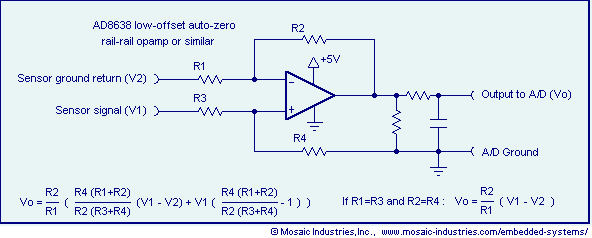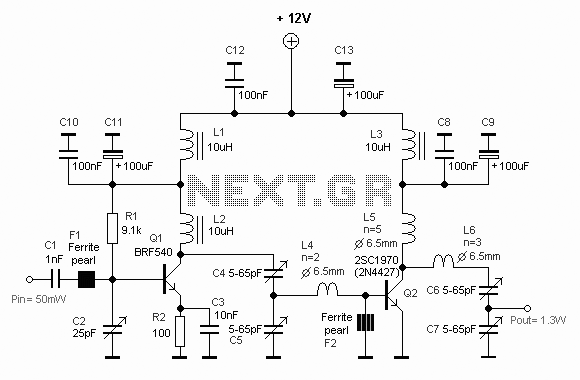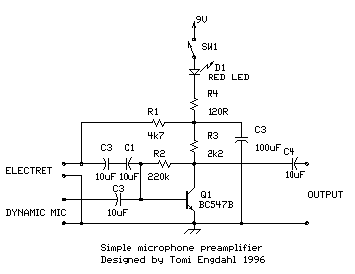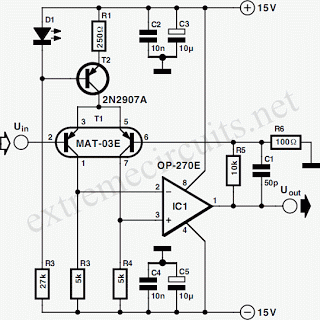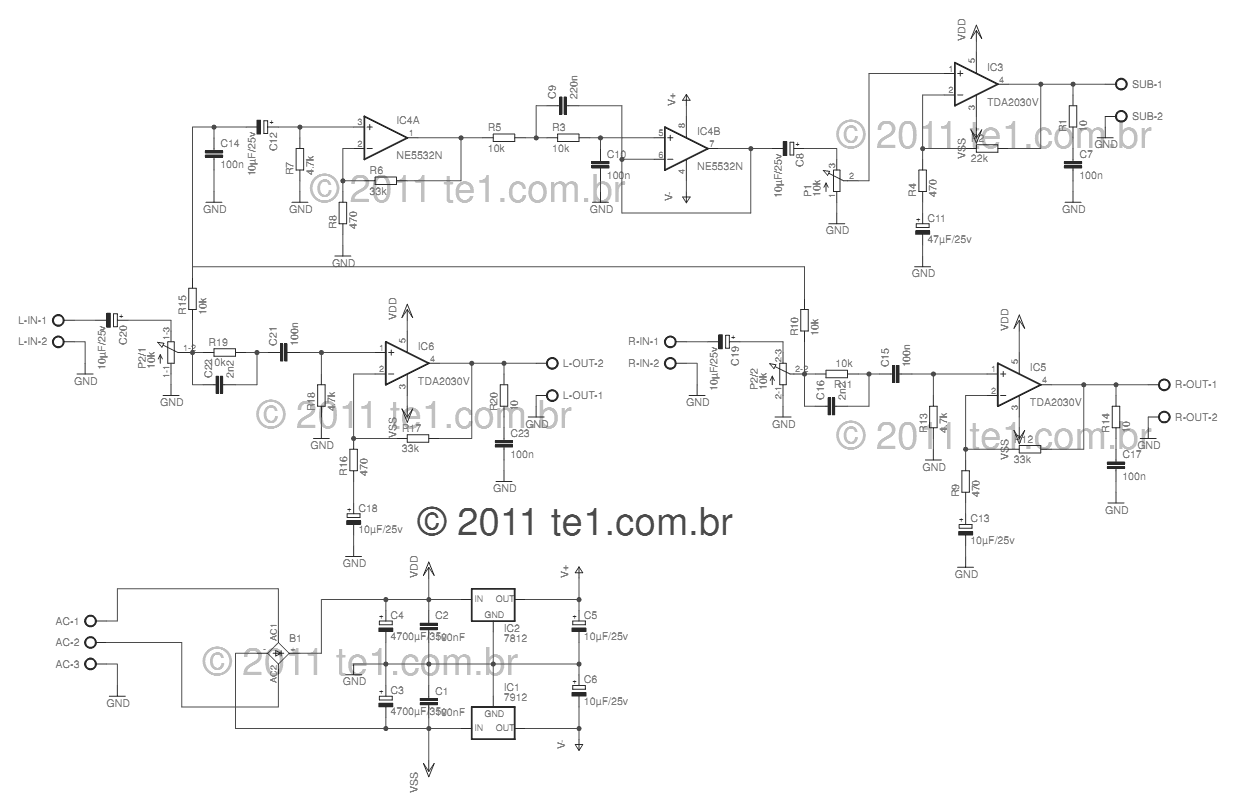
SiPM Amplifier
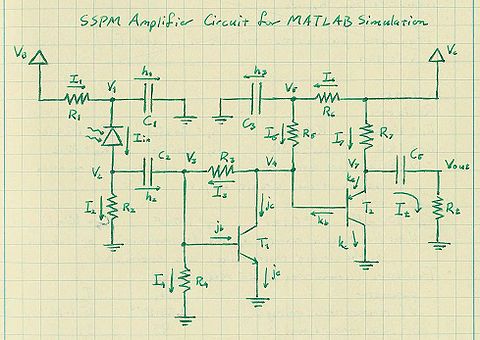
The silicon photomultipliers (SiPM) utilized in the experiment were acquired from Photonique, which also provides analog electronics boards to amplify the signals from the SiPMs. This document addresses the analysis and modeling of the amplifier circuit, along with the design of an amplifier suitable for the readout of the tagger microscope. The amplifier circuit diagram presented was developed by integrating the diagram provided by Photonique, which lacked component values and contained several extraneous components, with a physical circuit that had most components labeled. A model for this circuit was created in MATLAB to simulate its behavior and examine various parameters, particularly gain as a function of power voltage. According to Photonique's documentation, the power voltage can be adjusted between four and nine volts to tune the amplifier's gain. The MATLAB model consists of a linearized system of twenty-four equations, with the circuit's voltages and currents being the twenty-four unknowns. Four input parameters are defined: input current (Iin, in amps), bias voltage (Vb, in volts), power voltage (Vc, in volts), and frequency (f, in hertz). The resistor values are primarily consistent with those provided in the diagram, although some were modified to align the model with actual data. A load resistor valued at 50 ohms was added from Vout to GND. The transistors are characterized by a series of parameters derived from the Gummel-Poon SPICE model, and estimates of the capacitor values were included. Simulations of the MATLAB model were conducted while varying the input parameters to collect data on the amplifier's response to each input. A baseline test was established with inputs Vb = 20V, Vc = 5V, f = 100MHz, and Iin = 1mA, after which one parameter was varied at a time to observe the responses. Varying the input current from 0 to 2A produced a linear response intersecting the origin, indicating that the amplifier possesses a transimpedance gain (programmable based on input parameters, particularly Vc) and no DC bias. A significant limitation of this model was its inability to predict high-frequency behavior. Although the inherent bandwidth of the transistors (4-5GHz) was not explicitly included in the model, low-pass behavior due to source capacitance and amplifier input impedance should naturally emerge in the solutions. More accurate modeling of the SiPM discharge as parallel injection of Iin alongside the intrinsic SiPM capacitor restored this behavior. The inclusion of this capacitance (denoted as CS) and a parallel current injection loop enhanced sensitivity to input impedance. This input impedance presented challenges in achieving the faster signals required for the tagger microscope electronics. Additional discussions on this issue can be found in a dedicated section titled "SiPM Amplifier Optimization."
The silicon photomultiplier (SiPM) system, integrated with an analog electronics board for signal amplification, represents a sophisticated approach to detecting and processing light signals. The amplifier circuit is critical for ensuring the accurate readout of signals from the SiPM, which is essential for applications such as particle detection and imaging. The integration of a MATLAB model allows for extensive simulation of the amplifier's performance, enabling the analysis of gain characteristics and operational parameters.
The amplifier circuit's design is based on a combination of theoretical and practical insights, where the initial schematic provided by Photonique serves as a foundation. The adjustments made to the resistor values and the introduction of a load resistor are crucial for achieving optimal performance. The choice of a 50-ohm load resistor is particularly relevant in ensuring impedance matching, which is vital for minimizing signal reflections and maximizing power transfer.
The linearized model developed in MATLAB is composed of twenty-four equations, representing a comprehensive analysis of the circuit's behavior. The four input parameters—input current, bias voltage, power voltage, and frequency—are essential for understanding the amplifier's response and tuning its performance. The ability to vary the power voltage between four and nine volts provides flexibility in adjusting the gain, which is a critical aspect of amplifier design.
The observations made regarding the amplifier's transimpedance gain highlight its significance in translating input current variations into output voltage changes. The linear relationship observed when varying the input current suggests a well-designed amplifier capable of maintaining a stable gain across a range of operating conditions. However, the limitations identified in high-frequency response necessitate further investigation and optimization.
The incorporation of capacitive effects and the modeling of SiPM discharge dynamics are essential steps in refining the amplifier design. By addressing the input impedance challenges, the overall performance of the amplifier can be enhanced, leading to faster signal processing capabilities. This is particularly important for applications requiring rapid detection and analysis of transient signals.
In summary, the integration of advanced modeling techniques with practical circuit design principles is crucial for developing effective SiPM amplifier systems. Ongoing optimization efforts will continue to enhance the performance and reliability of these systems in various applications.The silicon photomultipliers (SiPM) we are using in our experiment were purchased from Photonique. Photonique also supplies analog electronics boards to amplify the signals from the SiPMs. This page discusses the analysis and modeling of the amplifier circuit as well as design of the amplifier suitable for the readout of the tagger microscope. Th e amplifier circuit diagram shown below was developed through combining the diagram supplied by Photonique (lacking component values, and having several extra components) and the physical circuit (having most components labeled). We developed a model for this circuit in MATLAB to simulate its behavior and study various parameters, especially gain as a function of power voltage.
The Photonique documentation claims that the power voltage can be varied between four and nine volts in order to tune the gain of the amplifier. The MATLAB model is a linearized system of twenty-four equations, with the voltages and currents on the circuit being the twenty-four unknowns.
There are four input parameters: input current (Iin, in amps), the bias voltage (Vb, in volts), the power voltage (Vc, in volts), and the frequency (f, in hertz). The resistor values are mostly the same as the ones given for the above diagram, but some were changed to fit the model to actual data.
We also add a load resistor from Vout to GND, with a value of 50 ©. The transistors are described by a series of parameters from the Gummel-Poon SPICE model, and we included our best guesses of the capacitor values. We ran simulations of the MATLAB model while varying the input parameters to generate data on how the amplifier responds to each input.
We used as a baseline test the inputs Vb = 20V, Vc = 5V, f = 100MHz, and Iin = 1mA, then varied one parameter at a time to generate responses. Varying the input current from 0 to 2A results in a clean straight line that intersects the origin. Thus we can say that the amplifier has a transimpedance gain (programmable based on input parameters; in particular Vc) and no DC bias.
One of the principal limitations of this model turned out to be its inability to predict high-frequency behavior. Though the bandwidth inherent in the transistors themselves (4-5GHz) was not explicitly in the model, the low-pass behavior due to source capacitance and amplifier input impedance should appear in the solutions naturally.
It turned out that the more accurate modeling of the SiPM discharge as parallel injection of Iin in parallel with the intrinsic SiPM capacitor recovers this behavior. Including this capacitance (labeled CS) and a parallel current injection loop restored the sensitivity to input impedance.
This input impedance turned out to be a challenge for achieving faster signals desired in the tagger microscope electronics. This issue is further discussed in a dedicated page: SiPM Amplifier Optimization 🔗 External reference
The silicon photomultiplier (SiPM) system, integrated with an analog electronics board for signal amplification, represents a sophisticated approach to detecting and processing light signals. The amplifier circuit is critical for ensuring the accurate readout of signals from the SiPM, which is essential for applications such as particle detection and imaging. The integration of a MATLAB model allows for extensive simulation of the amplifier's performance, enabling the analysis of gain characteristics and operational parameters.
The amplifier circuit's design is based on a combination of theoretical and practical insights, where the initial schematic provided by Photonique serves as a foundation. The adjustments made to the resistor values and the introduction of a load resistor are crucial for achieving optimal performance. The choice of a 50-ohm load resistor is particularly relevant in ensuring impedance matching, which is vital for minimizing signal reflections and maximizing power transfer.
The linearized model developed in MATLAB is composed of twenty-four equations, representing a comprehensive analysis of the circuit's behavior. The four input parameters—input current, bias voltage, power voltage, and frequency—are essential for understanding the amplifier's response and tuning its performance. The ability to vary the power voltage between four and nine volts provides flexibility in adjusting the gain, which is a critical aspect of amplifier design.
The observations made regarding the amplifier's transimpedance gain highlight its significance in translating input current variations into output voltage changes. The linear relationship observed when varying the input current suggests a well-designed amplifier capable of maintaining a stable gain across a range of operating conditions. However, the limitations identified in high-frequency response necessitate further investigation and optimization.
The incorporation of capacitive effects and the modeling of SiPM discharge dynamics are essential steps in refining the amplifier design. By addressing the input impedance challenges, the overall performance of the amplifier can be enhanced, leading to faster signal processing capabilities. This is particularly important for applications requiring rapid detection and analysis of transient signals.
In summary, the integration of advanced modeling techniques with practical circuit design principles is crucial for developing effective SiPM amplifier systems. Ongoing optimization efforts will continue to enhance the performance and reliability of these systems in various applications.The silicon photomultipliers (SiPM) we are using in our experiment were purchased from Photonique. Photonique also supplies analog electronics boards to amplify the signals from the SiPMs. This page discusses the analysis and modeling of the amplifier circuit as well as design of the amplifier suitable for the readout of the tagger microscope. Th e amplifier circuit diagram shown below was developed through combining the diagram supplied by Photonique (lacking component values, and having several extra components) and the physical circuit (having most components labeled). We developed a model for this circuit in MATLAB to simulate its behavior and study various parameters, especially gain as a function of power voltage.
The Photonique documentation claims that the power voltage can be varied between four and nine volts in order to tune the gain of the amplifier. The MATLAB model is a linearized system of twenty-four equations, with the voltages and currents on the circuit being the twenty-four unknowns.
There are four input parameters: input current (Iin, in amps), the bias voltage (Vb, in volts), the power voltage (Vc, in volts), and the frequency (f, in hertz). The resistor values are mostly the same as the ones given for the above diagram, but some were changed to fit the model to actual data.
We also add a load resistor from Vout to GND, with a value of 50 ©. The transistors are described by a series of parameters from the Gummel-Poon SPICE model, and we included our best guesses of the capacitor values. We ran simulations of the MATLAB model while varying the input parameters to generate data on how the amplifier responds to each input.
We used as a baseline test the inputs Vb = 20V, Vc = 5V, f = 100MHz, and Iin = 1mA, then varied one parameter at a time to generate responses. Varying the input current from 0 to 2A results in a clean straight line that intersects the origin. Thus we can say that the amplifier has a transimpedance gain (programmable based on input parameters; in particular Vc) and no DC bias.
One of the principal limitations of this model turned out to be its inability to predict high-frequency behavior. Though the bandwidth inherent in the transistors themselves (4-5GHz) was not explicitly in the model, the low-pass behavior due to source capacitance and amplifier input impedance should appear in the solutions naturally.
It turned out that the more accurate modeling of the SiPM discharge as parallel injection of Iin in parallel with the intrinsic SiPM capacitor recovers this behavior. Including this capacitance (labeled CS) and a parallel current injection loop restored the sensitivity to input impedance.
This input impedance turned out to be a challenge for achieving faster signals desired in the tagger microscope electronics. This issue is further discussed in a dedicated page: SiPM Amplifier Optimization 🔗 External reference
